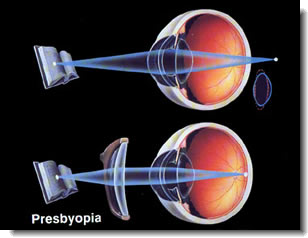
Presbyopia: What is it?
Symptoms You May Experience:
Examination: What Your Eye Doctor Will Look For:
What You Can Do:
When To Call Your M.D.:
Treatment:
Prognosis: Will I See Better?
Presbyopia is a decrease in the ability to see near objects. It is an expected part of the aging process. Normally, muscle fibers attached to the lens contract to change the shape of the lens, allowing near objects to come into focus. This is called accommodation. With increasing age, the lens hardens and loses elasticity, becoming less able to change its shape as each eye accommodates for near vision.
As you reach middle age (mid 40s), you will likely start to experience blurry vision when attempting to read, and you may find that you have to hold reading materials farther away to see them clearly. Additional symptoms may include eyestrain or headache.
Presbyopia is readily detected as part of a standard eye exam. Your doctor may test the ability of each eye to accommodate to near vision by bringing an object closer and closer to the eye until the vision blurs.
Presbyopia affects nearly all adults to some degree as they age. It is not preventable.
Presbyopia typically becomes most apparent during the mid 40s. It may occur at a slightly younger age for farsighted people, or at an older age for the nearsighted. You should see an eye doctor when you notice that you are no longer able to read or perform near tasks comfortably.
Presbyopia can typically be corrected with eyeglasses, which include reading glasses, bifocals, and progressive addition lenses, or with multifocal contact lenses. Over the counter reading glasses are an option for those whose distance vision does not require glasses. In select cases, refractive surgery (aka laser eye surgery) can aid in the correction of presbyopia.
Eyeglasses and contact lenses can usually fully correct presbyopia. However, you may need a more powerful reading prescription as you grow older, since changes in the lens and attached muscle fibers continue.

Contact Lenses | Glaucoma | Just For Fun | Eyeglasses | Eye Doctor | Eye Care And Symptoms | Eye Anatomy | Online Eye Tests | Laser Eye Surgery | Laser Eye Surgery Directory: Canada | Laser Eye Surgery Directory: USA | Laser Eye Surgery Reviews | Submit A Review | Contact Us | Privacy Policy | Sitemap
Copyright 2006-2009 Vision Health

